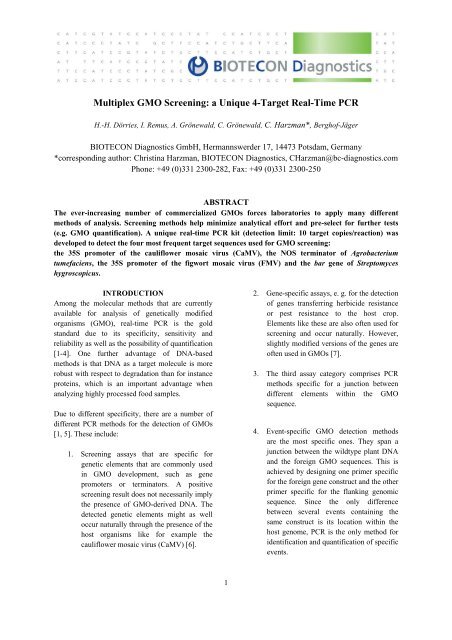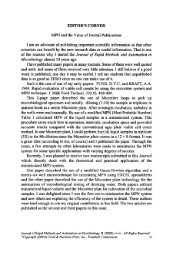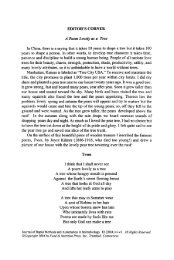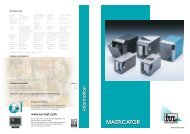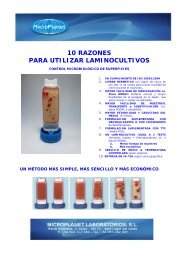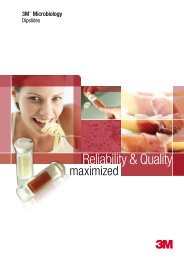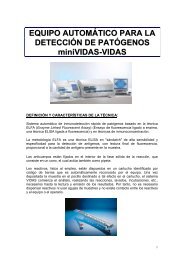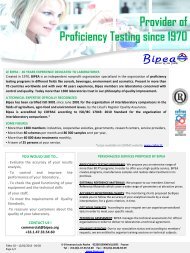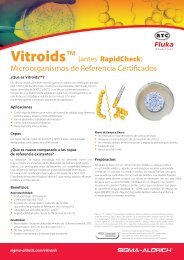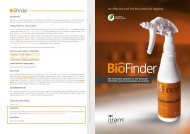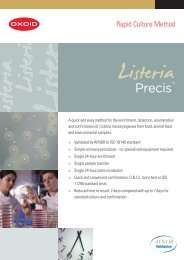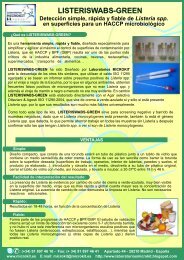Multiplex GMO Screening: a Unique 4-Target Real-Time PCR
Multiplex GMO Screening: a Unique 4-Target Real-Time PCR
Multiplex GMO Screening: a Unique 4-Target Real-Time PCR
You also want an ePaper? Increase the reach of your titles
YUMPU automatically turns print PDFs into web optimized ePapers that Google loves.
<strong>Multiplex</strong> <strong>GMO</strong> <strong>Screening</strong>: a <strong>Unique</strong> 4-<strong>Target</strong> <strong>Real</strong>-<strong>Time</strong> <strong>PCR</strong><br />
H.-H. Dörries, I. Remus, A. Grönewald, C. Grönewald, C. Harzman*, Berghof-Jäger<br />
BIOTECON Diagnostics GmbH, Hermannswerder 17, 14473 Potsdam, Germany<br />
*corresponding author: Christina Harzman, BIOTECON Diagnostics, CHarzman@bc-diagnostics.com<br />
Phone: +49 (0)331 2300-282, Fax: +49 (0)331 2300-250<br />
ABSTRACT<br />
The ever-increasing number of commercialized <strong>GMO</strong>s forces laboratories to apply many different<br />
methods of analysis. <strong>Screening</strong> methods help minimize analytical effort and pre-select for further tests<br />
(e.g. <strong>GMO</strong> quantification). A unique real-time <strong>PCR</strong> kit (detection limit: 10 target copies/reaction) was<br />
developed to detect the four most frequent target sequences used for <strong>GMO</strong> screening:<br />
the 35S promoter of the cauliflower mosaic virus (CaMV), the NOS terminator of Agrobacterium<br />
tumefaciens, the 35S promoter of the figwort mosaic virus (FMV) and the bar gene of Streptomyces<br />
hygroscopicus.<br />
INTRODUCTION<br />
Among the molecular methods that are currently<br />
available for analysis of genetically modified<br />
organisms (<strong>GMO</strong>), real-time <strong>PCR</strong> is the gold<br />
standard due to its specificity, sensitivity and<br />
reliability as well as the possibility of quantification<br />
[1-4]. One further advantage of DNA-based<br />
methods is that DNA as a target molecule is more<br />
robust with respect to degradation than for instance<br />
proteins, which is an important advantage when<br />
analyzing highly processed food samples.<br />
Due to different specificity, there are a number of<br />
different <strong>PCR</strong> methods for the detection of <strong>GMO</strong>s<br />
[1, 5]. These include:<br />
1. <strong>Screening</strong> assays that are specific for<br />
genetic elements that are commonly used<br />
in <strong>GMO</strong> development, such as gene<br />
promoters or terminators. A positive<br />
screening result does not necessarily imply<br />
the presence of <strong>GMO</strong>-derived DNA. The<br />
detected genetic elements might as well<br />
occur naturally through the presence of the<br />
host organisms like for example the<br />
cauliflower mosaic virus (CaMV) [6].<br />
1<br />
2. Gene-specific assays, e. g. for the detection<br />
of genes transferring herbicide resistance<br />
or pest resistance to the host crop.<br />
Elements like these are also often used for<br />
screening and occur naturally. However,<br />
slightly modified versions of the genes are<br />
often used in <strong>GMO</strong>s [7].<br />
3. The third assay category comprises <strong>PCR</strong><br />
methods specific for a junction between<br />
different elements within the <strong>GMO</strong><br />
sequence.<br />
4. Event-specific <strong>GMO</strong> detection methods<br />
are the most specific ones. They span a<br />
junction between the wildtype plant DNA<br />
and the foreign <strong>GMO</strong> sequences. This is<br />
achieved by designing one primer specific<br />
for the foreign gene construct and the other<br />
primer specific for the flanking genomic<br />
sequence. Since the only difference<br />
between several events containing the<br />
same construct is its location within the<br />
host genome, <strong>PCR</strong> is the only method for<br />
identification and quantification of specific<br />
events.
As there are currently more than 140 GM crops<br />
worldwide that have been approved for cultivation<br />
and human consumption, multiplex assays and<br />
effective test schemes utilizing the different<br />
methods mentioned above in a step-wise analysis<br />
have been established [8-9]. The initial step in<br />
routine <strong>GMO</strong> analysis is a preliminary screening<br />
assay to gather information in order to minimize the<br />
number of further identification and quantification<br />
tests [9]. As food processing often results in<br />
degraded DNA, assays for the determination of the<br />
overall quality of plant DNA in general are often<br />
used. Additionally, real-time <strong>PCR</strong> assays should<br />
always include an internal amplification control<br />
(IAC) for identification of false-negative results due<br />
to <strong>PCR</strong> inhibition.<br />
<strong>Multiplex</strong> methods for the dual detection of the<br />
CaMV 35S promoter and the terminator of the<br />
nopaline synthase gene of Agrobacterium<br />
tumefaciens (T-NOS or NOS) have been validated<br />
and are commonly used for <strong>GMO</strong> screening [10-<br />
11]. To thoroughly detect as many genetically<br />
modified crops as possible an expansion of existing<br />
screening methods is required. For this purpose,<br />
assays that are specific for other elements like e. g.<br />
the 35S promoter of the figwort mosaic virus<br />
(FMV) can be included [12]. The FMV promoter is<br />
part of the transgene sequence of new approved<br />
events like soya MON89788 (Roundup Ready 2<br />
Yield) and sugar beet H7-1 (Roundup Ready).<br />
The application of screening methods makes it also<br />
possible to detect non-approved <strong>GMO</strong>s for which<br />
no specific assays, reference material or even<br />
genetic sequences are available. Recently, a<br />
strategy was employed to detect unknown <strong>GMO</strong>s<br />
using arrays with 25 basepair probes covering both<br />
strands of a set of 235 vectors (2 million basepairs)<br />
without prior knowledge of the used transformation<br />
vectors [14].<br />
This technical paper summarizes the development<br />
of the foodproof ® <strong>GMO</strong> <strong>Screening</strong> Kit (35S, NOS,<br />
bar, FMV), 5’Nuclease. This is the first commercial<br />
kit offering multiplex real-time <strong>PCR</strong> for the<br />
screening of four <strong>GMO</strong> targets at once. The<br />
detection system contains an assay for the<br />
2<br />
simultaneous detection of four important genetic<br />
elements and a second assay for control of DNA<br />
integrity and inhibition control. The <strong>GMO</strong> assay is<br />
specific for the CaMV 35S promoter, the NOS<br />
terminator of Agrobacterium tumefaciens, the bar<br />
gene of the soil bacterium Streptomyces<br />
hygroscopicus and the FMV 35S promoter. An<br />
additional control assay detects plant DNA and the<br />
internal amplification control (IAC) for the<br />
identification of false-negative results.<br />
MATERIALS AND METHODS<br />
Sample Material and DNA Isolation. 26 bacterial,<br />
25 yeast and 13 mold species were used for the<br />
testing of the assay specificity. They were obtained<br />
from the DSMZ (Deutsche Sammlung von<br />
Mikroorganismen und Zellkulturen), the ATCC<br />
(American Type Culture Collection), the NCTC<br />
(National Collection of Type Cultures), the MUCL<br />
(Mycotheque de l'Universite catholique de<br />
Louvain) or the CBS (Centraalbureau voor<br />
Schimmelcultures). For further specificity testing,<br />
DNA was extracted from 41 non-genetically<br />
modified plants. DNA isolation was conducted with<br />
the foodproof ® ShortPrep II Kit for bacteria, with<br />
the foodproof ® StarPrep Four Kit for yeasts or<br />
molds and with the foodproof ® <strong>GMO</strong> Sample<br />
Preparation Kit (all three kits: BIOTECON<br />
Diagnostics GmbH, Potsdam, Germany) for plants.<br />
50 different food products out of different groups<br />
(e.g. maize, tacos, frozen food, popcorn, maize<br />
starch, muesli/cereal bars, tofu, meat substitute,<br />
soya beans, soya drinks, lectithin) were processed<br />
with the foodproof ® <strong>GMO</strong> Sample Preparation Kit<br />
for the applicability study. 5 µl of the unspiked<br />
sample preparations made with the foodproof ®<br />
<strong>GMO</strong> Sample Preparation Kit were used for <strong>PCR</strong>.<br />
Afterwards, samples were artificially contaminated<br />
by spiking 3 µl of the sample preparations with 2 µl<br />
of a mix containing purified and quantified DNA<br />
(200 target copies/µl) from the following <strong>GMO</strong><br />
reference material: MON 89788 (AOCS 0906-B),<br />
Bt176 (IRMM-411) and EH92-527-1 (IRMM-421).<br />
Further <strong>GMO</strong> reference materials were obtained<br />
from Sigma-Aldrich or AOCS (American Oil<br />
Chemists' Society): GTS 40-3-2 (IRMM-410),<br />
MON 89788 (AOCS 0906-B), A2704-12 (AOCS<br />
0707-B), Bt11 (IRMM-412), Bt176 (IRMM-411),
CBH-351 (Sigma-Aldrich, 69407), GA 21 (Sigma-<br />
Aldrich, 69407), MIR604 (IRMM-423), MON 810<br />
(IRMM-413), MON 863 (IRMM-416), NK 603<br />
(Sigma-Aldrich, 69407), T25 (AOCS 0306-H),<br />
TC1507 (IRMM-418), GS40/90 (Sigma-Aldrich,<br />
55231), GT200/GT73 (Sigma-Aldrich, 55231),<br />
MS8xRf3 (Sigma-Aldrich, 55231), Oxy235<br />
(Sigma-Aldrich, 55231), T45 (AOCS 0208-A),<br />
LLRice62 (AOCS 0707-B), H7-1 (IRMM-419),<br />
EH92-527-1 (IRMM-421) and LLCotton25 (AOCS<br />
0306-E).<br />
LOD (limit of detection) determination as well as<br />
the spiking of prepared food samples were carried<br />
out with protein-free and RNA-free DNA from<br />
<strong>GMO</strong> reference material, quantified<br />
photometrically with a NanoPhotometer (Implen<br />
GmbH, München, Germany). The number of the<br />
target sequence copies was calculated by assuming<br />
that the haploid genome sizes of soya, maize, sugar<br />
beet and potato are 1.1 pg, 2.7 pg, 0.9 pg and 0.9<br />
pg, respectively [15].<br />
<strong>Real</strong>-time <strong>PCR</strong>. The foodproof ® <strong>GMO</strong> <strong>Screening</strong><br />
Kit (35S, NOS, bar, FMV) for the detection of<br />
genetically modified organisms consists of two<br />
real-time <strong>PCR</strong> systems based on hydrolysis (5’nuclease)<br />
probes or TaqMan ® technology. Each<br />
system consists of a premade master mix<br />
(35S/NOS/bar/FMV or Plant Gene Master Mix)<br />
containing primers, probes and all further necessary<br />
reagents, an enzyme solution and an internal<br />
amplification control or dye solution. The enzyme<br />
solution contains blocked “HotStart” Taq DNA<br />
polymerase and the enzyme uracil-DNA<br />
glycosylase (UDG) for decontamination and thus<br />
prevention of false-positive results. Furthermore, a<br />
positive control DNA is also provided with the kit<br />
for all five assays.<br />
Four <strong>PCR</strong> assays specific for screening elements<br />
commonly used in <strong>GMO</strong>s were designed for the<br />
35S/NOS/bar/FMV Master Mix. The amplicons of<br />
the CaMV 35S promoter, the 3'-untranslated region<br />
of the nopaline synthase gene of Agrobacterium<br />
tumefaciens (NOS terminator), the bar resistance<br />
gene (phosphinothricin N-acetyltransferase,<br />
transferring herbicide resistance) of the soil<br />
3<br />
bacterium Streptomyces hygroscopicus and the<br />
FMV 35S promoter were simultaneously detected<br />
using specific hydrolysis probes and visualized by<br />
monitoring the resulting fluorescent signal of the<br />
four used reporter fluorescence dyes. The reporter<br />
dyes attached to the 5’-end of the <strong>GMO</strong>-specific<br />
probes were FAM (6-carboxy-fluorescein) for the<br />
35S assay, HEX (6-carboxy-2',4,4',5',7,7'hexachlorofluorescein)<br />
for the NOS assay, ROX (5carboxy-X-rhodamine)<br />
for the bar assay and Cy5<br />
for the FMV assay. At the 3’end all probes were<br />
labeled with a dark quencher.<br />
The Plant Gene Master Mix contains specific<br />
oligonucleotides for the detection of plant-derived<br />
DNA and a homologous internal amplification<br />
control (IAC). The IAC, which contains the<br />
fragment of the plant target with a modified probe<br />
binding sequence, is amplified by the primers of the<br />
plant assay but the amplicon is detected with a<br />
different probe. For the detection of the plant gene<br />
and the IAC the probes were labeled with FAM and<br />
HEX at the 5’-end and with a dark quencher at the<br />
3’-end, respectively.<br />
<strong>PCR</strong> was set up according to the supplier’s<br />
instructions. For each reaction 18 µl<br />
35S/NOS/bar/FMV Master Mix or Plant Gene<br />
Master Mix were mixed with 1 µl Enzyme Solution<br />
and 1 µl Dye Solution (35S/NOS/bar/FMV system)<br />
or 1 µl Internal Amplification Control (Plant Gene<br />
system). 20 µl of either master mix were then<br />
transferred into the corresponding well of a 96multiwell<br />
<strong>PCR</strong> plate and 5 µl <strong>PCR</strong> grade water<br />
(negative control), 5 µl positive control or 5 µl of<br />
food sample DNA were added, respectively.<br />
<strong>PCR</strong> conditions were the following:<br />
1. Pre-incubation and initial denaturation:<br />
4 min at 37 °C<br />
10 min at 95 °C<br />
2. Amplification (50 cycles)<br />
5 s at 95 °C<br />
60 s at 60 °C (signal acquisition)<br />
Fluorescence signals were measured after the<br />
second step of the amplification program.
<strong>Real</strong>-time <strong>PCR</strong> experiments were run on the<br />
LightCycler 480 instrument (Roche Diagnostics<br />
GmbH, Mannheim, Germany) or the Mx3005P<br />
Q<strong>PCR</strong> System (Agilent Technologies, Waldbronn,<br />
Germany). Each experiment consisted of the<br />
samples to be analyzed as well as one positive and<br />
one negative control each for both master mixes<br />
(35S/NOS/bar/FMV and Plant Gene).<br />
RESULTS AND DISCUSSION<br />
Specificity. Primer and probe concentrations,<br />
reaction conditions and <strong>PCR</strong> profile were adjusted<br />
in order to optimize the performance of both<br />
multiplex assays. The expected results were<br />
achieved for all tested reference materials with the<br />
35S/NOS/bar/FMV Master Mix and the Plant Gene<br />
Master Mix after testing with the LightCycler 480<br />
instrument (Table 1). Only events containing the<br />
respective screening target were positive with the<br />
corresponding assay and all events were positive<br />
with the plant-specific assay. It can be predicted<br />
from databases that the 35S/NOS/bar/FMV Master<br />
Mix detects almost all of the <strong>GMO</strong> events for<br />
which information on the inserted genetic elements<br />
is available [13]. Only two soybean events<br />
(DP305423 and DP356043) and one canola event<br />
(GT200) lacking the target sequences cannot be<br />
detected with this four-target screening method.<br />
Conclusions regarding the identity of a <strong>GMO</strong> can<br />
be made based on the combination of screening<br />
targets present or absent in a sample. The detection<br />
of a screening element in a sample can thus narrow<br />
the group of possible events present. A soybean<br />
sample with e. g. a positive signal for the FMV 35S<br />
promoter should in a next step be checked for the<br />
presence of the event MON 89788 (Roundup<br />
Ready2Yield).<br />
The identification of <strong>GMO</strong> events can be hampered<br />
by the tendency that more transgenic varieties have<br />
several (pyramided) traits incorporated [16].<br />
Distinguishing stacked events produced by<br />
hybridization from a mixture of the parent lines by<br />
event-specific assays could not be achieved.<br />
Besides, an overestimation of the relative <strong>GMO</strong><br />
level in a sample containing stacked event is<br />
possible [17]. With regard to this problem, an<br />
4<br />
enhanced multiplex <strong>PCR</strong> technique for eventspecific<br />
detection of maize event Bt11 x GA21 was<br />
recently described [18]. For <strong>GMO</strong> analysis more<br />
and more new assays are developed for the<br />
simultaneous detection and identification of<br />
multiple target sequences [19]. The use of multiplex<br />
<strong>PCR</strong> assays <strong>GMO</strong> detection and identification has<br />
been described previously [20-26]. Microarray<br />
technology can potentially play an important role in<br />
the future through the parallel detection of multiple<br />
<strong>GMO</strong>-related sequences per sample [27-28].<br />
Table 1: <strong>Real</strong>-time <strong>PCR</strong> results with certified reference<br />
material of different <strong>GMO</strong> events<br />
Reference<br />
<strong>PCR</strong> assay<br />
material 35S NOS bar FMV Plant<br />
Soya<br />
GTS 40-3-2 + + - - +<br />
MON 89788 - - - + +<br />
A2704-12 + - - - +<br />
Maize<br />
Bt11 + + - - +<br />
Bt176 + - + - +<br />
CBH-351 + + + - +<br />
GA 21 - + - - +<br />
MIR604 - + - - +<br />
MON 810 + - - - +<br />
MON 863 + + - - +<br />
NK 603 + + - - +<br />
T25 + - - - +<br />
TC1507 + - - - +<br />
Canola<br />
GS40/90 + - - - +<br />
GT200/GT73 - - - + +<br />
MS8 x Rf3 - + + - +<br />
Oxy235 + + - - +<br />
T45 + - - - +<br />
Rice<br />
LLRice62 + - + - +<br />
Sugar beet<br />
H7-1 - - - + +<br />
Potato<br />
EH92-527-1 - + - - +<br />
Cotton<br />
LLCotton25 + - + - +<br />
(+) positive result with specific <strong>PCR</strong> assay; (-) negative<br />
result with specific <strong>PCR</strong> assay<br />
The method’s exclusivity was tested with nontarget<br />
DNA from different bacteria species, yeasts,<br />
molds and non-genetically modified plants (see
Table 2). No amplification of any DNA sample<br />
with the 35S/NOS/bar/FMV Master Mix was<br />
observed. <strong>PCR</strong> inhibition was precluded for the<br />
bacterial DNA samples by the amplification of the<br />
internal amplification control.<br />
All plant samples could be amplified with the Plant<br />
Gene Master Mix verifying that the integrity of the<br />
target DNA was not influenced by the DNA<br />
isolation and purification process.<br />
Sensitivity. The lowest quantity or concentration<br />
that can be reliably detected with an acceptance<br />
criterion is defined as the limit of detection (LOD).<br />
LOD determination of the <strong>GMO</strong>-specific assays<br />
was done with quantified and purified DNA of the<br />
events MON 89788, H7-1, EH92-527-1, MON 810,<br />
Bt 176 and GA 21. For each target sequence a serial<br />
10-fold dilution of known concentrations (1,000 to<br />
1 copies/reaction) was analyzed in 15 replicates.<br />
The number of genome equivalents (Nge) per µl was<br />
calculated according to the following equation:<br />
Nge/µl = DNA-concentration [ng/µl] x 1000/haploid<br />
genome [pg]. All four <strong>GMO</strong> target assays had an<br />
absolute LOD of 10 initial template copies per<br />
reaction (Table 3).<br />
The actual amount of genome equivalents in a <strong>PCR</strong><br />
sample ranges from approximately 18,500 (50 ng<br />
sample DNA) to 74,000 (200 ng sample DNA) if a<br />
mass of 2.7 pg for an unreplicated haploid maize<br />
genome (C value) was assumed [15]. Therefore, a<br />
relative concentration of 0.05 % <strong>GMO</strong> genomes in<br />
a sample (9.3 or 37.0 genome equivalents of the<br />
<strong>GMO</strong>) was detectable with the <strong>GMO</strong> targeting<br />
assays. Thus, the system can reliably detect the<br />
relative <strong>GMO</strong> content to monitor e.g. the European<br />
0.9 % labeling system. Previous studies of event<br />
specific real-time <strong>PCR</strong> assays also had a limit of<br />
detection of 10 to 20 initial template copies per<br />
reaction [29-30].<br />
The Cp value differences that were detected with<br />
the maize events MON 810 and Bt 176 were caused<br />
by differences in the reference material used for<br />
DNA extraction. 20 genome equivalents resulted in<br />
a Cp value of 24.50 for MON 810 and 31.96 for Bt<br />
176 with the Plant Gene Master Mix. It was shown<br />
5<br />
by gel electrophoresis that the DNA extracted from<br />
the Bt 176 flour was more degraded than the DNA<br />
from the MON 810 flour (data not shown). In<br />
general, DNA derived from flour is more processed<br />
and of lower quality than the reference material<br />
which was delivered as DNA, because much of the<br />
DNA is degraded [29]. For protein preparations<br />
made from soya and for processed tomato products<br />
the available target sequences range from 100 to<br />
400 bp [31], which is why assays with as small as<br />
possible amplicon size are demanded. For this<br />
purpose locked nucleic acid (LNA) 5’-nuclease<br />
probes could be used to reduce the size of the<br />
amplified fragments [32].<br />
Robustness. The kit performance was tested with<br />
50 different food products in order to simulate a<br />
sample matrix more relevant to the situation in the<br />
food industry. No positive results were detected for<br />
the unspiked food samples with the<br />
35S/NOS/bar/FMV Master Mix (data not shown).<br />
In the food samples spiked with 400 copies/reaction<br />
of all four target sequences the parallel detection of<br />
all four sequences was possible. The single assays<br />
did not influence each other.<br />
<strong>PCR</strong> assays might be influenced by substances like<br />
polysaccharides, phenolic compounds, proteins and<br />
other secondary plant metabolites which are coextracted<br />
from plant and food samples [33-34].<br />
<strong>PCR</strong> inhibition through processed food with high<br />
lipid content or food subjected to intense thermal<br />
treatments was sometimes observed [35]. In case of<br />
the presented assay, the results show that a high<br />
amount of non-target DNA from different food<br />
matrices had no negative influence on the target<br />
sequence amplification.<br />
Additional experiments carried out on the Mx3005p<br />
instrument showed that the detection of 10<br />
copies/reaction was possible (data not shown). Thus<br />
the compatibility of the method with real-time<br />
instruments other than the LightCycler 480 was<br />
proven.<br />
CONCLUSION<br />
The foodproof® <strong>GMO</strong> <strong>Screening</strong> Kit (35S, NOS,<br />
bar, FMV) allows the qualitative multiplex
Table 2: Results of the specificity testing with non-target DNA from bacterial species, yeasts, molds and non-genetically modified plants<br />
Species (collection no.) 35S/NOS/bar/ Cp Cp IAC Plant 35S/NOS/bar/ Cp Cp IAC<br />
FMV detection* Plant<br />
FMV detection* Plant<br />
Bacillus firmus (DSM 12) - - 34.89 Apple - 33.11 33.74<br />
Bacillus stearothermophilus (DSM 456) - - 34.61 Banana - 22.59 -<br />
Buttiauxella agrestis (DSM 4586) - - 34.67 Pear - 29.79 32.07<br />
Cedecea davisae (DSM 4568) - - 43.72 Cauliflower - 23.18 -<br />
Citrobacter koseri (DSM 4595) - - 34.73 Bean (green) - 32.55 33.67<br />
Clostridium perfringens (DSM 12709) - - 34.48 Bean (red) - 34.99 34.52<br />
Enterobacter aerogenes (DSM 30053) - - 34.83 Bean (white) - 22.73 -<br />
Enterobacter amnigenus (DSM 4486) - - 34.46 cashew nut - 24.66 -<br />
Enterobacter intermedius (DSM 4581) - - 35.38 Curcuma - 25.69 -<br />
Cronobacter sakazakii (DSM 4485) - - 35.04 Chicory - 23.30 -<br />
Ewingella americana (DSM 4580) - - 35.09 Spelt - 22.68 -<br />
Erwinia carotovora (DSM 30168) - - 35.20 Pea - 20.82 -<br />
Erwinia chrysanthemi (DSM 4610) - - 35.07 Strawberry - 24.57 -<br />
Escherichia blattae (NCTC 12127) - - 35.58 Peanut - 25.09 -<br />
Escherichia coli (NCTC 12790) - - 35.66 Oats - 23.97 -<br />
Escherichia hermanii (DSM 4560) - - 34.69 Hazelnut - 21.35 -<br />
Escherichia vulneris (DSM 4564) - - 35.11 Sorghum - 23.13 -<br />
Hafnia alvei (DSM 30163) - - 41.89 Honeydew melon - 26.65 -<br />
Klebsiella oxytoca (DSM 5175) - - 34.20 Potato - 22.76 -<br />
Klebsiella planticola (DSM 4617) - - 34.9 Coco - 25.56 -<br />
Klebsiella terrigena (DSM 2687) - - 34.81 Pumpkin - 23.92 -<br />
Kluyvera ascorbata (DSM 4611) - - 35.38 Linseed - 28.08 29.89<br />
Kluyvera cryocrescens (DSM 4588) - - 35.24 Lense - 21.35 -<br />
Leclercia adecarboxylata (SM 5077) - - 34.77 Almond - 20.68 -<br />
Moellerella wisconsensis (DSM 5076) - - 35.48 Nutmeg - 28.66 29.52<br />
Plesiomonas shigelloides (DSM 8224) - - 35.04 Para nut - 30.86 -<br />
Candida albicans (ATCC 10231) - - 35.60 Pecan - 25.13 -<br />
Candida inconspicua (MUCL 27868) - - 35.30 Parsley - 30.55 32.82<br />
Candida tropicalis (ATCC 20247) - - 35.03 Plum - 32.63 33.81<br />
Clavispora lusitaniae (DSM 70102) - - 35.55 Pistachio - 20.73 -<br />
Cryptococcus albidus (DSM 70197) - - 35.07 Rice - 26.58 -<br />
Debaryomyces etchelsii (ATCC 20126) - - 35.08 Rye - 21.38 -<br />
Dekkera bruxellensis (DSM 3429) - - 34.82 Sesame - 21.10 -<br />
Endomyces fibuliger (DSM 70554) - - 34.71 Sunflower - 22.84 -<br />
Filobasidium capsuligenum (DSM 70253) - - 35.07 Soya - 22.21 -<br />
Guilliermondella selenospora (DSM 3431) - - 34.90 Spinach - 21.60 -<br />
Hanseniaspora guilliermondii (DSM 70285) - - 35.33 Tobacco - 22.29 -<br />
Hyphopichia burtonii (DSM 3505) - - 35.90 Tomato - 29.27 30.99<br />
Issatchenkia orientalis (CBS 5147) - - 34.93 Tomato puree - 33.86 34.01<br />
Kluyveromyces marxianus (DSM 70106) - - 35.08 Walnut - 21.20 -<br />
Lachancea thermotolerans (CBS 6340) - - 35.51 Wheat - 22.19 -<br />
Lodderomyces elongisporus (DSM 70320) - - 34.82<br />
Metschnikowia pulcherrima (DSM 70321) - - 34.79<br />
Pichia anomala (DSM 70783), - - 35.69<br />
Rhodotorula minuta (DSM 70408) - - 34.92<br />
Saccharomyces bayanus (DSM 70412) - - 35.34<br />
Saccharomyces cerevisiae (ATCC 9763) - - 34.72<br />
Schizosaccharomyces pombe (DSM 70844) - - 34.95<br />
Torulaspora delbrueckii (CBS 5636) - - 34.79<br />
Yarrowia lipolytica (ATCC 20225) - - 34.87<br />
Zygosaccharomyces rouxii (DSM 70835) - - 35.66<br />
Absidia corymbifera (DSM 1144) - - 34.93<br />
Alternaria citri (CBS 106.27) - - 35.57<br />
Aspergillus fumigates (DSM 819) - - 34.77<br />
Aspergillus penicillioides (DSM 1623) - - 35.97<br />
Claviceps purpurea (DSM 714) - - 34.46<br />
Diaporthe citri (DSM 1159) - - 35.12<br />
Eupenicillium abidjanum (DSM 2207) - - 34.98<br />
Fusarium culmorum (DSM 62184) - - 34.26<br />
Monilia fructigena (DSM 2678) - - 35.03<br />
Mucor racemosus (CBS 225.37) - - 35.52<br />
Neurospora crassa (DSM 1129) - - 34.93<br />
Penicillium camembertii (DSM 1995) - - 35.27<br />
Wallemia sebi (DSM 5329) - - 35.04<br />
(-) negative with specific <strong>PCR</strong> assay; Cp = crossing point; IAC = internal amplification control<br />
*all tested organisms were negative in all four fluorescence channels with the 35S/NOS/bar/FMV Master Mix<br />
6
screening for the presence of <strong>GMO</strong>s with a<br />
detection limit of 10 target DNA copies per <strong>PCR</strong><br />
reaction, which is well below the European<br />
regulations requirements. The compatibility of this<br />
method was proven on real-time instruments the<br />
LightCycler 480 (Roche Diagnostics GmbH,<br />
Mannheim, Germany) and the Mx3005P Q<strong>PCR</strong><br />
System (Agilent Technologies, Waldbronn,<br />
Germany). The foodproof® <strong>GMO</strong> <strong>Screening</strong> Kit<br />
provides a basis for a rapid, sensitive and reliable<br />
screening of food and feed for the most frequently<br />
used genetic elements present in GM crops.<br />
BIOTECON DIAGNOSTICS<br />
COMPANY INFORMATION<br />
BIOTECON Diagnostics is a biotechnology<br />
company that focuses on development, production<br />
and marketing of <strong>PCR</strong>-based rapid detection<br />
systems. We offer solutions for the detection of<br />
pathogens and <strong>GMO</strong>s for the food and beverage<br />
industry as well as for producers of pharmaceuticals<br />
and cosmetics. For more information about the<br />
foodproof® <strong>GMO</strong> <strong>Screening</strong> Kit and to learn about<br />
the foodproof <strong>GMO</strong> Soya or Maize Quantification<br />
Kits also offered by BIOTECON Diagnostics,<br />
contact the author or visit www.bc-diagnostics.com.<br />
REFERENCES<br />
1. Anklam E, Gadani F, Heinze P, Pijnenburg H, Van<br />
den Eede G (2002) Eur Food Res Technol 214: 3–26<br />
2. Alexander T W, Reuter T, Aulrich K, Sharma R,<br />
Okine E K, Dixon W T, McAllister T A (2007)<br />
Anim Feed Sci Technol 133:31-62<br />
3. Miraglia M, Berdal K G, Brera C, Corbisier P,<br />
Holst-Jensen A, Kok E J, Marvin H J P, Schimmel<br />
H, Rentsch J, van Rie J P P F, Zagon, J (2004) Food<br />
Chem Toxicol 42:1157-1180<br />
4. Community Reference Laboratory, GM Food and<br />
Feed, Ispra, http://gmocrl.jrc.ec.europa.eu/statusofdoss.htm<br />
5. Holst-Jensen A, Rønning S B, Løvseth A and Berdal<br />
K G (2003) Anal Bioanal Chem 375:985–993<br />
6. Wolf C, Scherzinger M, Wurz A, Pauli U, Hübner P,<br />
Lüthy J (2000) Eur Food Res Technol 210:367-372<br />
7. Marmiroli N, Maestri E, Gullì M, Malcevschi A,<br />
Peano C, Bordoni R, de Bellis G (2008) Anal<br />
Bioanal Chem 392:369-384<br />
8. James C (2008) ISAAA Brief 39<br />
9. Michelini E, Simoni P, Cevenini L, Mezzanotte L,<br />
Roda A (2008) Anal Bioanal Chem 392:355-367<br />
7<br />
10. Waiblinger H U, Ernst B, Anderson A, Pietsch K<br />
(2008) Eur J Food Res Technol 226:1221-1228<br />
11. Technische Regel BVL L 00.00-122 (2008)<br />
12. Waiblinger H U, Boernsen B, Pietsch K (2008) Deut<br />
Lebensm-Rundsch 104:261-264<br />
13. AGBIOS, http://www.agbios.com/main.php<br />
14. Tengs T, Kristoffersen A, Berdal K, Thorstensen T,<br />
Butenko M, Nesvold H, Holst-Jensen A (2007)<br />
BMC Biotechnol 7:91<br />
15. Bennett M D, Leitch I J (1997) Ann Bot 80:169-196<br />
16. Halpin C (2005) Plant Biotechnol 3:141-155<br />
17. Akiyama H, Watanabe T, Wakabayashi K, Nakade<br />
S, Yasui S, Sakata K, Chiba R, Spiegelhalter F, Hino<br />
A, Maitani T (2005) Anal Chem 77:7421-7428<br />
18. Xu W, Yuan Y, Luo Y, Bai W, Zhang C, Huang K<br />
(2009) J Agric Food Chem 57:395-402<br />
19. Chaouachi M, Chupeau G, Berard A, McKhann H,<br />
Romaniuk M, Giancola S, Laval V, Bertheau Y,<br />
Brunel D (2008) ) J Agric Food Chem 56:11596-<br />
11606<br />
20. Matsuoka T, Kuribara H, Akiyama H, Miura H,<br />
Goda Y, Kusakabe Y, Isshiki K, Toyoda M and<br />
Hino A (2001) J Food Hyg Soc Jpn 42:24-32<br />
21. James D, Schmidt A-M, Wall E, Green M and Masri<br />
S (2003) J Agric Food Chem 51:5829–5834<br />
22. Shrestha H K, Hwu K-K, Wang S-J, Liu L-F and<br />
Chang M-C (2008) J Agric Food Chem 56:8962-<br />
8968<br />
23. Onishi M, Matsuoka T, Kodama T, Kashiwaba K,<br />
Futo S, Akiyama H, Maitani T, Furui S, Oguchi T,<br />
Hino A (2005) J Agric Food Chem 53:9713-9721<br />
24. Germini A, Zanetti A, Salati C, Rossi S, Forre C,<br />
Schmid S, Marchelli R (2004) J Agric Food Chem<br />
52:3275-3280<br />
25. Hernandez M, Rodriguez-Lazaro D, Zhang D,<br />
Esteve T, Pla M, Prat S (2005) J Agric Food Chem<br />
53:3333-3337<br />
26. Gaudron T, Peters C, Boland E, Steinmetz A, Moris<br />
G (2009) Eur Food Res Technol 229:295-305<br />
27. Xu J, Miao H, Wu H, Huang W, Tang R, Qiu M,<br />
Wen J, Zhu S, Li Y (2006) Biosens Bioelectron<br />
22:71-77<br />
28. Leimanis S, Hernández M, Fernández S, Boyer F,<br />
Burns M, Bruderer S, Glouden T, Harris N,<br />
Kaeppeli O, Philipp P, Pla M, Puigdomènech P,<br />
Vaitilingom M, Bertheau Y, Remacle J (2006) Plant<br />
Mol Biol 61:123-139<br />
29. Rønning S B, Vaïtilingom M, Berdal K G and Holst-<br />
Jensen A (2003) Eur Food Res Technol 216:347–<br />
354<br />
30. Huang C-C, Pan T-M (2005) J Agric Food Chem<br />
53:3833-3839
31. Hemmer W (1997) Foods derived from genetically<br />
modified organisms and detection methods. BATS-<br />
Report 2/1997, Agency for Biosafety Research and<br />
Assessment of Technology Impacts of the Swiss<br />
Priority Program Biotechnology of the Swiss<br />
National Science Foundation, Basel, Switzerland<br />
32. Salvi S, D’Orso F, Morelli G (2008) J Agric Food<br />
Chem 56:4320-4327<br />
33. Holden M J, Blasic J R, Bussjaeger L, Kao C,<br />
Shokere L A, Kendall, D C (2003) J Agric Food<br />
Chem 51:2468-2474<br />
34. Wilson I G (1997) Appl Environ Microbiol 63:3741-<br />
3751<br />
35. Cazzola M L and Petruccelli S (2006) Electronic J<br />
Biotechnol 9:320-325<br />
8
Table 3: Amplification data for the determination of the absolute LOD of the 35S, NOS, bar and FMV assays and for the sensitivity of the plant assay<br />
35S/NOS/bar/FMV Master Mix<br />
template<br />
copies per<br />
reaction<br />
Soya MON 89788<br />
(FMV-promoter)<br />
Rate of Mean Cp<br />
recovery values (CV)<br />
Sugar beet H7-1<br />
(FMV-promoter)<br />
Rate of Mean Cp<br />
recovery values (CV)<br />
Potato EH92-527-1<br />
(NOS-terminator)<br />
Rate of Mean Cp<br />
recovery values (CV)<br />
Maize MON 810<br />
(35S-promoter)<br />
Rate of Mean Cp<br />
recovery values (CV)<br />
Maize Bt 176<br />
(35S-promoter/bar gene)<br />
Rate of<br />
Mean Cp values (CV)<br />
recovery<br />
Maize GA 21<br />
(NOS-terminator)<br />
Rate of Mean Cp values<br />
recovery (CV)<br />
1000 15/15 29.03 (0.33) 15/15 29.91 (0.93) 15/15 29.78 (0.56) 15/15 28.97 (4.73) 15/15; 15/15 29.79 (2.24); 30.93 (1.62) 15/15 29.53 (0.54)<br />
100 15/15 32.14 (0.56) 15/15 32.89 (0.70) 15/15 32.83 (0.80) 15/15 31.70 (3.61) 15/15; 15/15 32.59 (1.59); 33.68 (1.37) 15/15 33.10 (1.59)<br />
10 15/15 34.54 (1.77) 15/15 34.82 (2.03) 15/15 35.15 (1.66) 15/15 33.85 (0.35) 15/15; 15/15 34.69 (1.73); 35.57 (1.95) 15/15 35.51 (2.13)<br />
1 6/15 35.47 (2.73) 7/15 35.18 (0.73) 12/15 36.18 (3.45) 8/15 35.25 (1.82) 7/15; 7/15 36.07 (1.25); 37.19 (0.74) 3/15 36.59 (0.93)<br />
Soya MON 89788 Sugar beet H7-1<br />
Plant Master Mix<br />
Potato EH92-527-1 Maize MON 810 Maize Bt 176 Maize GA 21<br />
Nge per Mean Cp Nge per Mean Cp Nge per Mean Cp Nge per Mean Cp Nge per Mean Cp Nge per Mean Cp<br />
reaction values (CV) reaction values (CV) reaction values (CV) reaction values (CV) reaction values (CV) reaction values (CV)<br />
1000 19.74 (0.46) 1000 21.72 (1.94) 1000 20.92 (0.50) 20000 14.08 (0.40) 20000 21.83 (1.26) 50000 15.75 (2.10)<br />
100 23.14 (0.36) 100 25.04 (1.82) 100 24.37 (1.93) 2000 17.59 (1.30) 2000 25.20 (0.95) 5000 19.50 (3.40)<br />
10 26.62 (0.44) 10 28.17 (1.01) 10 27.56 (0.82) 200 21.11 (1.71) 200 28.66 (1.41) 500 23.07 (3.42)<br />
1 29.94 (0.54) 1 31.54 (1.29) 1 30.92 (0.66) 20 24.50 (1.02) 20 31.96 (1.29) 50 26.36 (2.24)<br />
Cp = crossing point; CV = coefficient of variation; Nge = genome equivalents<br />
9


